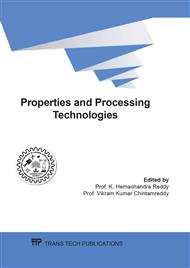p.45
p.51
p.57
p.65
p.73
p.79
p.91
p.99
p.107
Modelling of Flow Behaviour and Rheological Properties of M2 Steel in Semisolid State
Abstract:
The present study develops a model to investigate time dependent behaviours of M2 steel in semisolid state during step-change in shear rate. The Couette flow of the semisolid material between two parallel plates is considered. The flow field is presented by momentum conservation equation. The non-Newtoniun behaviour of the semisolid material is expressed by the Herschel-Bulkley model. The agglomeration and de-agglomeration phenomena of the suspended particles in semisolid state under shear are represented introducing a time dependent structural parameter. The proposed model fitted well with existing work in a wide range of shear rates and could predict the flow and apparent viscosity of semisolid M2 steel. Finally, the work involves prediction of the flow field, rate of strain and apparent viscosity of the semisolid material under transient condition. It is observed that the time dependent viscosity is highly non-linear during step-change in shear rate. It is noticed that the structural parameter decreases as the shear rate is increased. Whereas, the apparent viscosity decreases with increasing shear rate but shows an undulation and after that gradually rises to a higher steady value as the plate velocity decreases suddenly.
Info:
Periodical:
Pages:
73-78
Citation:
Online since:
April 2021
Authors:
Keywords:
Price:
Сopyright:
© 2021 Trans Tech Publications Ltd. All Rights Reserved
Share:
Citation:


